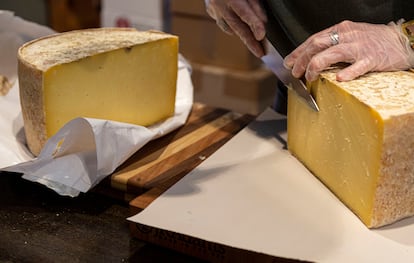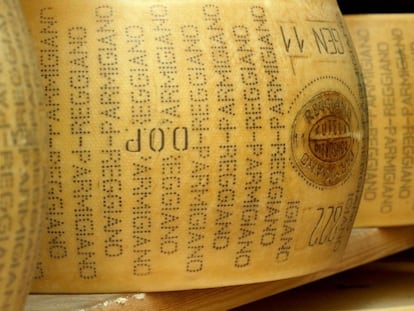The distinctive taste of cheddar cheese is due to microbes
A study reveals the complex interactions between bacteria that give one of the world’s most popular cheeses its unique flavor

The world of cheese is so extraordinarily diverse that there is no consensus on the number of varieties that exist throughout the world. But all the hundreds of types, or even thousands, have one thing in common: they are full of bacteria, yeasts and molds. Although science has an in-depth understanding of the activity of these microbes during the milk fermentation process that gives rise to cheese, it remains a mystery how they determine its aroma and flavor. An international research team has set out to unravel how microorganisms make cheddar, one of the world’s most popular cheeses, so distinctive. And the results of that scientific effort have were published this past Thursday in the journal Nature Communications.
Knowing exactly what role microbes play both in the functioning of our bodies and in the properties of foods is a growing field of interest for science. We already knew that lactic acid bacteria, for example, produce compounds called acetoin and diacetyl, which are also found in butter, which is why some cheeses have that taste. Also, that the yeast Geotrichum candidum produces a mixture of alcohols, fatty acids and other compounds that is responsible for the fruity aroma characteristic of cheeses such as brie or camembert.
Now, researchers have focused on cheddar, originally from the English county of Somerset, which has become a gastronomic classic in many countries and accompanies all kinds of dishes, from burgers to pasta. To address the secret to the flavor of this popular cheese, computational biologist Chrats Melkonian, microbiologist Ahmad Zeidan and other colleagues from the food science company Chr. Hansen in Denmark conducted year-long experiments with batches of cheddar using variants of a culture with combinations of bacterial strains.
“It’s a novel approach,” says Baltasar Mayo, a research professor at the Asturias Dairy Products Institute in Spain, who was not involved in the study. Mayo explains that microorganisms in foods are constantly being studied, but it is not usual to do so over 12 months during the production of a cheese. Thanks to this approach, the authors of the study discovered the crucial role of Streptococcus thermophilus in the growth of other bacteria, the Lactococcus, which in turn turned out to have a significant impact on flavor: the presence of Lactococcus cremoris limited the formation of unpleasant compounds and, on the other hand, the elimination of certain Lactococcus strains revealed the presence of specific compounds, highlighting the importance of each component in the flavor palette.
Throughout the experiment, the researchers observed specific population dynamics, including the relevance of Streptococcus thermophilus in the microbial community, especially between the two-week-mark and three months. The absence of this bacterium resulted in notable differences in the concentration of compounds over time, evidencing both its critical role in growth during fermentation and its long-term effect on flavor development. Francisco Zorrilla, co-author of the study from the University of Cambridge, highlights that they also identified another competitive interaction (between Lactococcus cremoris and Lactococcus lactis) due to the nutrients available in milk, which is associated with the fruity, creamy and nutty flavors of the final product.
How to mix bacteria and predict the flavor
According to Mayo, “it is complex to decipher what function everything has within the matrix, where many types of chemicals and reactions are found.” Regarding this complexity, Zorrilla points out that flavor depends not only on individual microbes, but also on the interactions between them: “This is an important consideration for future applications,” he says, adding that the findings of his study can provide tools for the rational design of microbial communities for a wide range of cheeses.
This research, however, not only sheds light on the secrets of cheddar cheese flavor, but also opens the door to new applications in the food industry in general. Conscious manipulation of microbial combinations could improve consistency and flavor quality in growing fields such as plant-based foods. According to another of the study’s authors, Chrats Melkonian, the elimination of undesirable flavors and toxic compounds, “is essential to achieve a pleasant and safe final product.” The authors point out that more experiments and research are needed, but say that in the future “artificial intelligence can be used to predict which organisms and in what quantities can produce desirable flavors.”
Sign up for our weekly newsletter to get more English-language news coverage from EL PAÍS USA Edition
Tu suscripción se está usando en otro dispositivo
¿Quieres añadir otro usuario a tu suscripción?
Si continúas leyendo en este dispositivo, no se podrá leer en el otro.
FlechaTu suscripción se está usando en otro dispositivo y solo puedes acceder a EL PAÍS desde un dispositivo a la vez.
Si quieres compartir tu cuenta, cambia tu suscripción a la modalidad Premium, así podrás añadir otro usuario. Cada uno accederá con su propia cuenta de email, lo que os permitirá personalizar vuestra experiencia en EL PAÍS.
¿Tienes una suscripción de empresa? Accede aquí para contratar más cuentas.
En el caso de no saber quién está usando tu cuenta, te recomendamos cambiar tu contraseña aquí.
Si decides continuar compartiendo tu cuenta, este mensaje se mostrará en tu dispositivo y en el de la otra persona que está usando tu cuenta de forma indefinida, afectando a tu experiencia de lectura. Puedes consultar aquí los términos y condiciones de la suscripción digital.
More information
Últimas noticias
The complicated life of Francesca Albanese: A rising figure in Italy but barred from every bank by Trump’s sanctions
How Japan is trying to avert ‘digital defeat’
Reinhard Genzel, Nobel laureate in physics: ‘One-minute videos will never give you the truth’
Pinochet’s victims grapple with José Antonio Kast’s rise in Chile
Most viewed
- Pablo Escobar’s hippos: A serious environmental problem, 40 years on
- Why we lost the habit of sleeping in two segments and how that changed our sense of time
- Trump’s obsession with putting his name on everything is unprecedented in the United States
- The Florida Keys tourist paradise is besieged by immigration agents: ‘We’ve never seen anything like this’
- Charles Dubouloz, mountaineering star, retires at 36 with a farewell tour inspired by Walter Bonatti











































